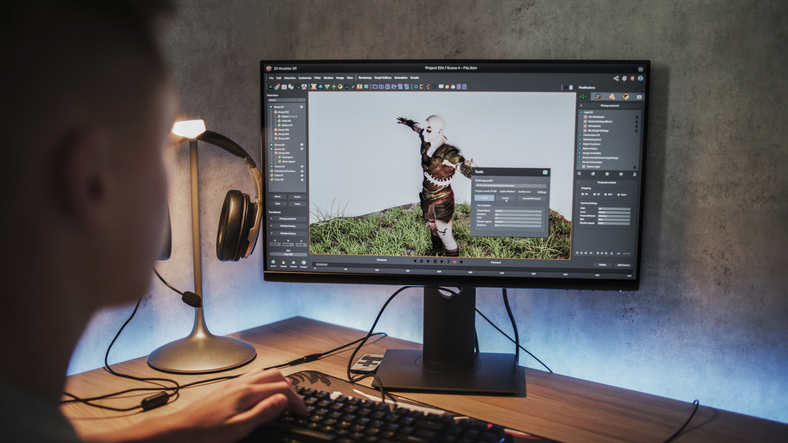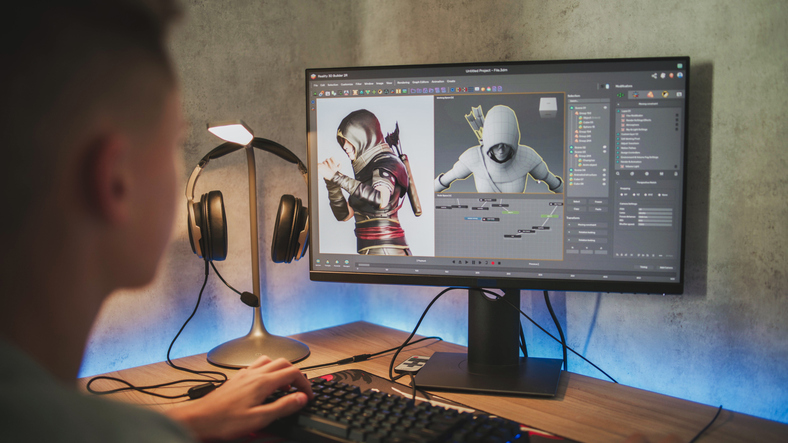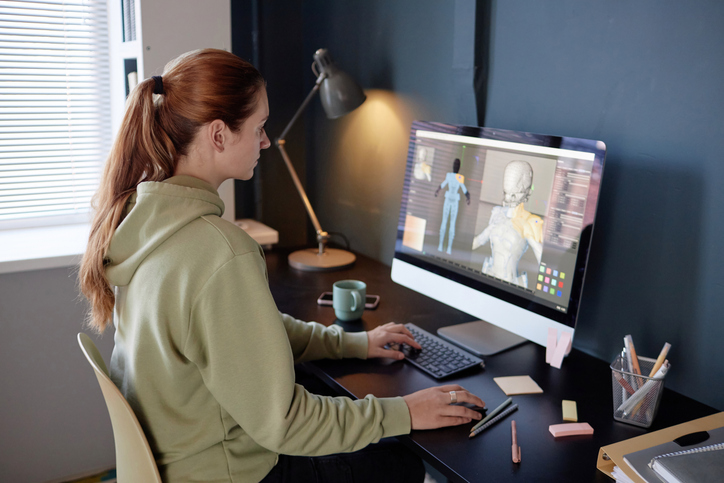Are you someone who loves visuals, storytelling, and bringing ideas to life through art? Are you passionate about creating stunning designs that leave a lasting impression? If so, a career in graphic design may be perfect for you. Graphic designers play a crucial role in the creative industry, helping companies build strong brand identities and communicate effectively through visual content. Whether you dream of working with major brands, designing user friendly websites, or crafting eye catching social media posts, this guide will walk you through everything you need to know about how to become a graphic designer in Canada.
From mastering the fundamentals of design to choosing the right educational path, we’ll explore the essential steps to get you started and show you how VCAD’s Graphic Design Diploma Program can launch your creative career in the right direction.
What is Graphic Design?
Graphic design is a form of visual communication that blends art and technology to convey ideas and messages. At its core, it involves the thoughtful arrangement of typography, imagery, colours, icons, illustrations, and layouts to create visuals that engage, inform, and inspire an audience. Whether through digital platforms or print media, graphic design helps simplify complex information and elevate how people interact with a brand or concept.
Graphic design is everywhere from the packaging of your favourite snacks and the logos of beloved brands to the interfaces of mobile apps, street billboards, book covers, and the layout of websites. It goes beyond making things look attractive; it serves a clear purpose. Graphic designers use visual hierarchy, balance, contrast, and other design principles to guide the viewer's attention and create a specific experience.
A well-designed piece can evoke emotion, encourage action, build brand trust, and even change perceptions. For example, a nonprofit may use powerful imagery and minimal typography to spark empathy and drive donations, while a tech company may use sleek, modern layouts and colour palettes to communicate innovation and reliability.
In today’s visually driven world, graphic design plays a critical role in branding, marketing, communication, and user experience. It’s not just about creativity, it’s about strategy, storytelling, and problem solving through design.
Understanding What a Graphic Designer Does
Graphic designers are more than just artists, they're visual storytellers and strategic thinkers who bring ideas to life through imagery, typography, layout, and colour. Their job is to take complex concepts or brand messages and translate them into visuals that are both aesthetically appealing and purpose driven.
At the heart of their work is communication. Whether it's a sleek logo, a compelling advertisement, or a user-friendly website interface, graphic designers ensure that every element on the page contributes to a cohesive and effective message. Their ability to evoke emotion, guide behaviour, and create memorable brand experiences makes them a vital part of any marketing, advertising, or communications team.
Day to day responsibilities may include:
- Developing creative visual concepts for everything from social media campaigns to product launches.
- Designing across multiple formats, including digital graphics, web layouts, email newsletters, posters, packaging, and print collateral.
- Collaborating with stakeholders like marketing teams, art directors, and clients to understand the project’s objectives, target audience, and desired outcomes.
- Using professional design software like Adobe Photoshop, Illustrator, and InDesign to bring ideas from concept to execution.
- Pitching ideas and presenting concepts, accepting feedback constructively, and revising designs until they meet expectations.
- Staying ahead of design trends and technology, ensuring that their work remains fresh, modern, and relevant.
Graphic designers also wear many hats depending on their work environment:
- In house designers focus on one brand and ensure consistency across all brand communications.
- Agency designers work with a variety of clients across industries, often juggling multiple fast paced projects.
- Freelance designers operate as independent creatives, managing everything from design to business operations like invoicing and client outreach.
No matter where they work, graphic designers are creative problem solvers who play a vital role in how people experience and engage with the world around them. It's a career path that thrives on curiosity, continuous learning, and a passion for impactful design.
How to Become a Graphic Designer in Canada: Step by step guide
If you’re wondering how to become a graphic designer in Canada, the journey involves a combination of creativity, education, technical skills, and practical experience. It’s not a one size fits all path each designer’s journey is unique but by following these essential steps, you’ll be setting yourself up for success in this dynamic and growing field.
1. Start by Practicing Your Creativity
Every great designer begins with a spark of creativity. Whether you’re still in high school or just discovering your passion for design, this is the perfect time to experiment and explore. Try your hand at:
- Drawing, painting, or digital illustration
- Photography and visual storytelling
- Creating simple graphics using free design tools like Canva
- Designing posters, social media templates, or mock product packaging for fun
Taking high school electives, such as visual arts, graphic arts, or web design will give you early exposure to design concepts. Outside of school, take notice of logos, websites, advertisements, and even signage around you. Ask yourself: What makes this work visually compelling? What would I change? This practice will help develop your eye for detail and improve your design instincts.
2. Get a Formal Graphic Design Education (Optional but Beneficial)
While many successful designers are self-taught, a structured design program can accelerate your learning, provide mentorship, and connect you with industry professionals. Formal education gives you the opportunity to explore various areas of design, gain constructive feedback, and work on real world projects.
In a graphic design program, you’ll study key areas like:
- Colour theory and typography
- Composition and layout
- Branding and identity systems
- Web design and UX/UI fundamentals
- Illustration, packaging, and motion graphics
At VCAD, the Graphic Design Diploma goes beyond theory. It’s a practical, hands-on experience guided by instructors with real industry backgrounds. You’ll work on client style briefs, collaborate with peers, and graduate with a skillset that’s aligned with what employers in Canada are seeking.
Bonus Read: Do You Need a Degree to Become a Graphic Designer?
3. Learn Industry Standard Tools
Graphic designers rely heavily on professional software to bring their ideas to life. Mastering these tools is essential:
- Adobe Photoshop: Ideal for photo editing, digital painting, and layout creation
- Adobe Illustrator: Perfect for creating logos, icons, and vector illustrations
- Adobe InDesign: Used for brochures, magazines, presentations, and other layout heavy print materials
You’ll also benefit from familiarity with:
- Adobe XD or Figma: For prototyping and UX/UI design
- Canva: Useful for quick social media graphics and presentations
VCAD’s program provides extensive training in Adobe Creative Cloud, ensuring that you graduate comfortable and confident with the tools the industry expects you to use from day one.
4. Work on Projects & Build a Portfolio
Your portfolio is your most powerful asset as a designer, it’s how you showcase your creativity, technical skills, and range of experience. Unlike a resume, a portfolio offers tangible proof of what you can do.
If you’re just starting out, build your portfolio by:
- Recreating existing designs in your own style
- Designing branding for fictional businesses
- Volunteering for local nonprofits or community events
- Collaborating with friends on mock campaigns or design challenges
Aim for a variety of pieces that demonstrate your ability to work across mediums logos, web pages, print materials, ads, and packaging. Include short write ups with each piece explaining the objective, your process, and the tools used.
With VCAD’s support, you’ll work on a range of creative briefs throughout the program. By the time you graduate, you’ll have a professional portfolio that’s ready to impress employers and clients alike.
Bonus Read: How to Build a Graphic Design Portfolio
5. Get Experience Through Internships or Freelance Work
Nothing builds confidence like real world experience. Internships offer a chance to apply your skills in professional settings, learn how creative teams operate, and get feedback from experienced designers. Freelancing, meanwhile, teaches you how to manage client relationships, set timelines, and price your work.
Benefits of hands-on experience include:
- Understanding how to work under deadlines
- Getting constructive feedback to improve your designs
- Building your reputation and expanding your network
- Enhancing your resume and portfolio with real projects
6. Apply for Graphic Design Jobs in Canada
Once you’ve built up your skills, portfolio, and confidence, it’s time to start applying for jobs. Graphic designers are in demand across a wide variety of sectors, including:
- Advertising and marketing
- Publishing and editorial
- Tech and app development
- E commerce and retail
- Entertainment and media
Common entry level positions include:
- Junior Graphic Designer
- Visual Designer
- Marketing Designer
- UX/UI Designer
- Web Designer
To stand out, customize your application for each position. Tailor your resume and portfolio to the company’s style and highlight relevant projects. Consider including a short case study or design challenge that shows how you think as a designer.
VCAD’s career services offer resume reviews, mock interviews, and job search guidance to help you transition from student to professional seamlessly.
Bonus Read: Is Graphic Design a Good Career Choice in 2025?
7. Stay Updated and Keep Learning
Graphic design is constantly evolving with new tools, trends, and technologies like the use of AI in graphic design. To stay relevant and competitive, you need to embrace lifelong learning. Some ways to keep growing include:
- Following design blogs and YouTube tutorials
- Joining platforms like Behance and Dribbble
- Taking online courses on new software or design trends
- Attending local meetups, conferences, and webinars
Being a great designer means staying curious, flexible, and open to new inspiration. At VCAD, students are encouraged to stay engaged with the wider design community and keep expanding their skills beyond the classroom.
Why Choose VCAD’s Graphic Design Diploma Program
Choosing the right design school can make all the difference in launching your career. VCAD (Visual College of Art and Design) offers a comprehensive and industry focused Graphic Design Diploma Program designed for aspiring creatives in Canada.
Here’s what makes VCAD’s program stand out:
1. Hands On, Project Based Learning The curriculum focuses on practical, real-world projects that help students build technical proficiency and develop an impressive portfolio.
2. Expert Instructors from the Industry Students learn from professionals with extensive experience in design, advertising, and multimedia. This mentorship provides insights that go beyond the classroom.
3. Industry Standard Software Training Master essential design tools such as Adobe Photoshop, Illustrator, and InDesign through guided instruction and creative assignments.
4. Flexible Learning Options With both online and campus-based learning options, VCAD offers flexibility for students balancing other commitments.
5. Portfolio Development Support Students graduate with a polished portfolio that showcases a variety of creative skills essential for landing jobs and freelance gigs.
6. Career Support and Networking Opportunities From resume workshops to internship placements, VCAD helps students take confident steps into the workforce.
Final Thoughts
Becoming a graphic designer in Canada is an exciting and rewarding journey. With a combination of creative passion, technical training, and real-world experience, you can build a successful career in one of today’s most dynamic fields.
By following the steps outlined in this guide and investing in your future through a program like VCAD’s Graphic Design Diploma, you’ll be well on your way to transforming your artistic talent into a thriving professional career.
Ready to get started? Explore VCAD’s Graphic Design Diploma today and turn your creativity into a career!














